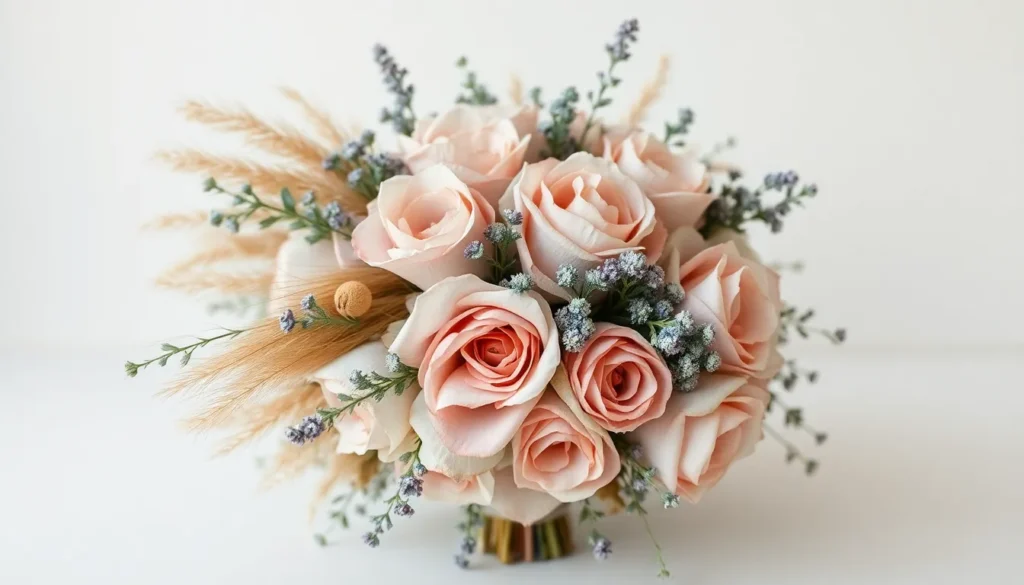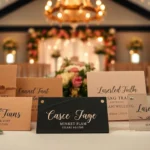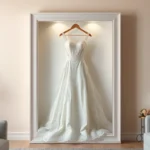Preserving your wedding bouquet doesn’t have to mean watching those beautiful blooms wilt away in a vase. We’ve discovered that dried wedding bouquets are becoming the ultimate trend for brides who want their special day to last forever – and we’re absolutely obsessed with the possibilities.
Dried flowers aren’t just trendy; they’re timeless. We love how they capture that romantic vintage aesthetic while offering incredible versatility for your big day. From rustic pampas grass arrangements to delicate dried roses that’ll make your heart skip a beat, these bouquets photograph beautifully and won’t leave you worrying about wilting petals during your ceremony.
The best part? You’ll get to keep your bouquet as a stunning home décor piece long after you’ve said “I do.” We’re sharing our favorite dried wedding bouquet ideas that’ll transform your bridal look and give you that perfect blend of bohemian charm and classic elegance that’s absolutely Instagram-worthy.
Choose Classic Eucalyptus and Baby’s Breath Combinations
Classic pairings never go out of style, and eucalyptus with baby’s breath creates the perfect foundation for dried wedding bouquets. These timeless botanicals complement each other beautifully while maintaining their elegant appearance long after your wedding day.
Select Silver Dollar Eucalyptus for Texture
Silver dollar eucalyptus brings sophisticated texture and natural movement to dried bouquet arrangements. We love how these round, silvery leaves create visual interest without overwhelming delicate flowers like roses or peonies. The sturdy stems hold their shape exceptionally well during the drying process, making them ideal for long-term preservation.
Each silver dollar leaf adds dimension to your bouquet’s silhouette while providing a neutral backdrop for colorful blooms. The matte finish of dried eucalyptus leaves catches light beautifully in photographs, creating depth that enhances your wedding memories. Most florists recommend using 3-5 stems of silver dollar eucalyptus per medium-sized bouquet to achieve the perfect balance.
Add Wispy Baby’s Breath for Romance
Baby’s breath transforms any dried bouquet into a dreamy, romantic masterpiece with its delicate cloud-like appearance. We find that this classic filler flower maintains its ethereal quality even after drying, creating soft texture that photographs beautifully. The tiny white blooms add vintage charm while filling gaps between larger statement flowers.
Fresh baby’s breath dries naturally within 2-3 weeks when hung upside down in a cool, dry location. The dried stems become more fragile but retain their romantic appeal for months when handled carefully. Consider using baby’s breath as a border around your bouquet’s edge or weaving it throughout eucalyptus stems for maximum visual impact.
Create Rustic Pampas Grass Arrangements
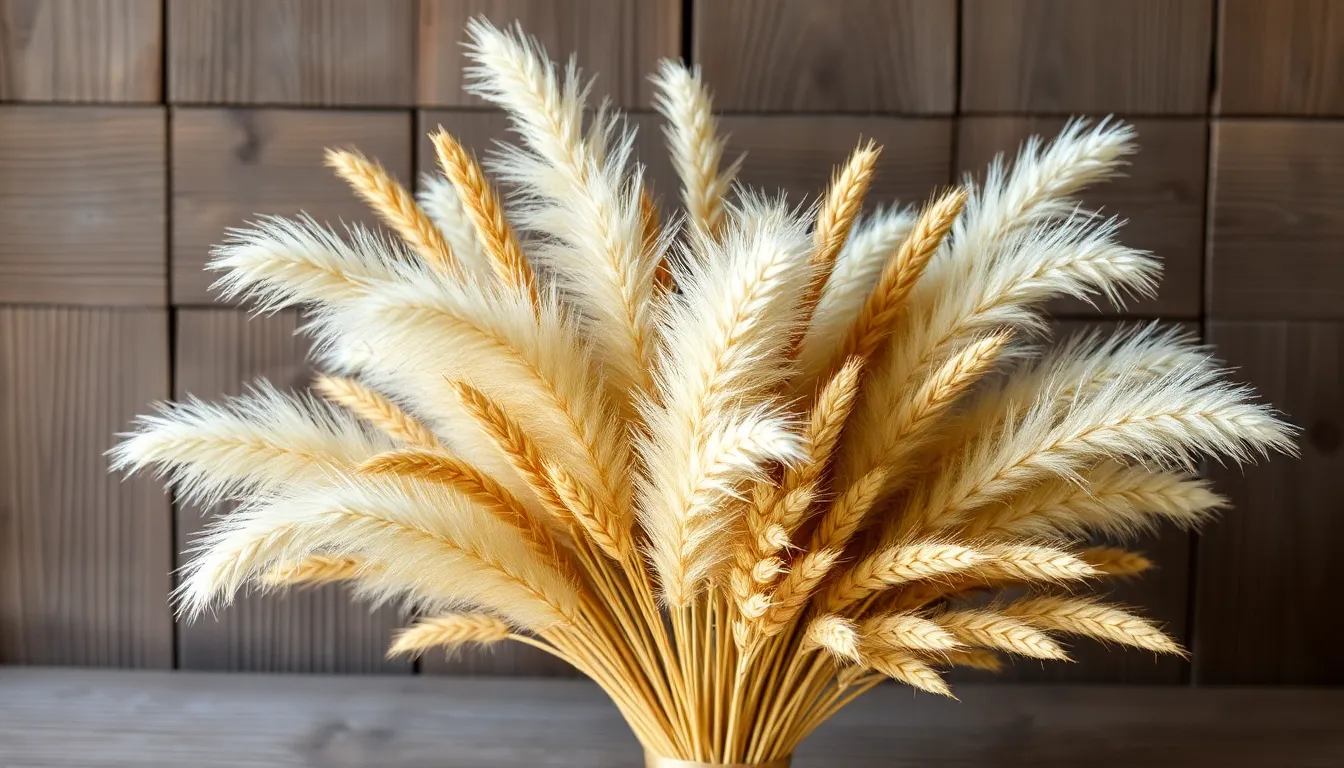
Pampas grass brings natural elegance to dried wedding bouquets with its feathery texture and sophisticated appeal. These arrangements capture the essence of bohemian romance while maintaining the durability that makes dried bouquets so special.
Incorporate Neutral Toned Pampas Plumes
Start with cream and beige plumes as your foundation for a cohesive neutral palette. These soft tones create a versatile base that complements virtually any wedding color scheme without overwhelming delicate accent flowers.
Layer different plume sizes to add visual depth and dimension to your arrangement. We recommend combining large statement plumes with smaller accent pieces to create a balanced composition that photographs beautifully.
Position plumes at varying heights throughout the bouquet to establish natural movement and flow. This technique mimics how pampas grass grows in nature and prevents your arrangement from looking too structured or formal.
Choose plumes with full, fluffy textures over sparse or damaged ones for the most luxurious appearance. Quality pampas grass maintains its shape throughout your wedding day and beyond, making it an excellent investment for your dried bouquet.
Mix in Dried Wheat Stalks for Farmhouse Appeal
Bundle wheat stalks in small clusters of 3-5 stems to create natural looking groupings within your bouquet. These golden stalks add warmth and rustic charm that perfectly complements the soft neutrals of pampas grass.
Trim wheat stalks to different lengths for a more organic, field gathered appearance. We suggest keeping some stems slightly taller than your pampas plumes while tucking shorter pieces throughout the arrangement.
Secure wheat bundles with floral wire before incorporating them into your bouquet to prevent individual stalks from shifting or falling out during handling. This technique ensures your farmhouse inspired arrangement stays intact throughout your celebration.
Combine wheat with other dried grains like barley or oats for added texture and visual interest. These natural elements enhance the countryside aesthetic while maintaining the neutral color palette that makes pampas grass arrangements so timeless.
Design Vintage-Inspired Rose and Lavender Bouquets
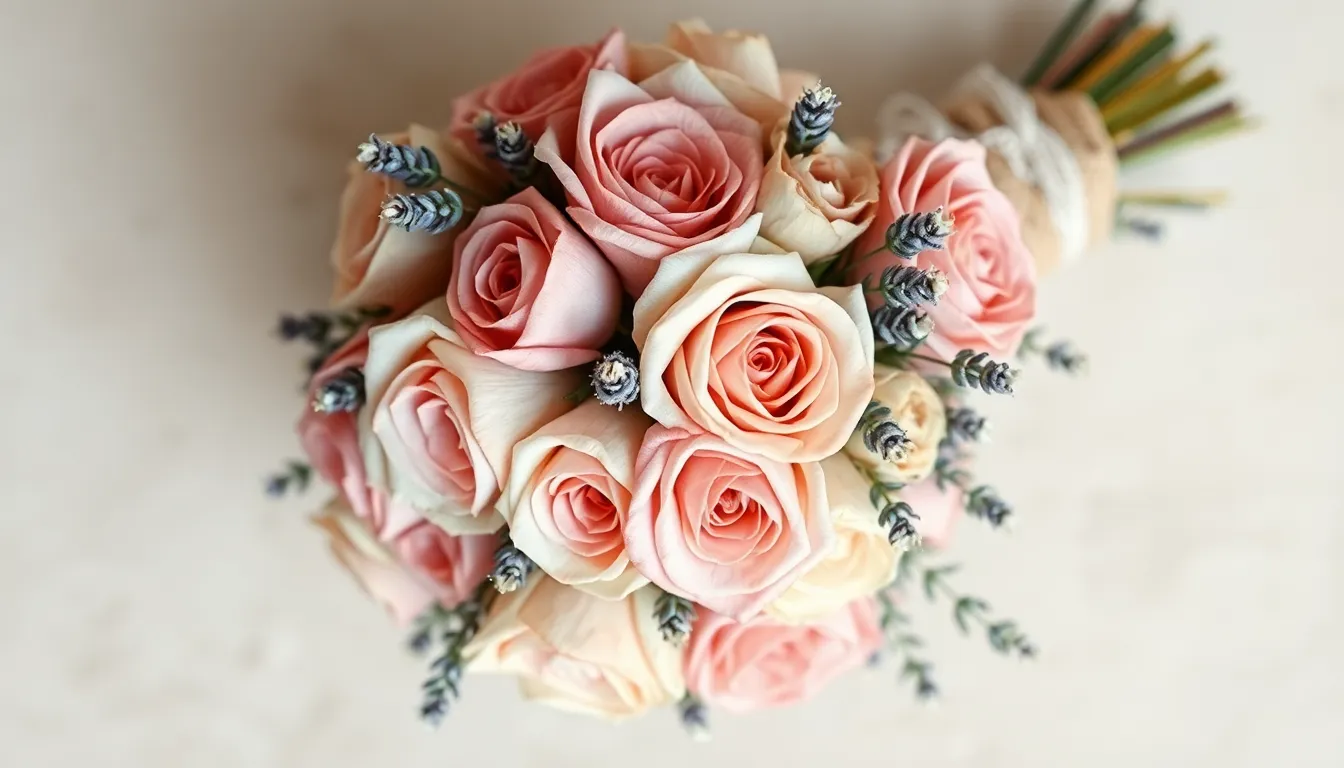
Combining dried roses with lavender creates the perfect vintage aesthetic that captures timeless romance and nostalgic charm.
Use Dried Garden Roses as Focal Points
Garden roses serve as stunning centerpieces due to their lush, romantic petals that maintain their beautiful shape even after drying. Their naturally soft color palette creates the classic elegance that makes vintage themes so appealing to modern brides.
Muted tones work exceptionally well because they blend seamlessly with other dried botanicals while providing that coveted vintage look. We recommend selecting roses in dusty pink, cream, or soft peach shades to achieve the most authentic vintage aesthetic.
Positioning these roses strategically throughout your bouquet ensures they remain the main feature while creating visual balance. Their substantial size and romantic appeal make them ideal anchors for more delicate elements like lavender and smaller accent flowers.
Include Fragrant Dried Lavender Sprigs
Lavender sprigs introduce both texture and delightful aroma that enhances the sensory experience for you and your wedding guests. The delicate purple hues create a beautiful contrast against soft rose tones while adding rustic charm to your arrangement.
Generous accents of lavender work best when interspersed between your focal roses rather than clustered in one area. This distribution technique ensures the fragrance spreads throughout the bouquet while maintaining visual harmony.
Rustic stems add authentic vintage character that perfectly complements the romantic nature of dried roses. We suggest leaving some lavender stems slightly longer than others to create natural movement and organic flow within your bouquet design.
Wrapping options enhance the vintage appeal when you choose materials like lace, burlap, or vintage ribbon to complete your arrangement. These sustainable dried bouquets can be preserved for years as cherished keepsakes, making them both practical and environmentally conscious choices for your special day.
Craft Bohemian Protea and Thistle Displays
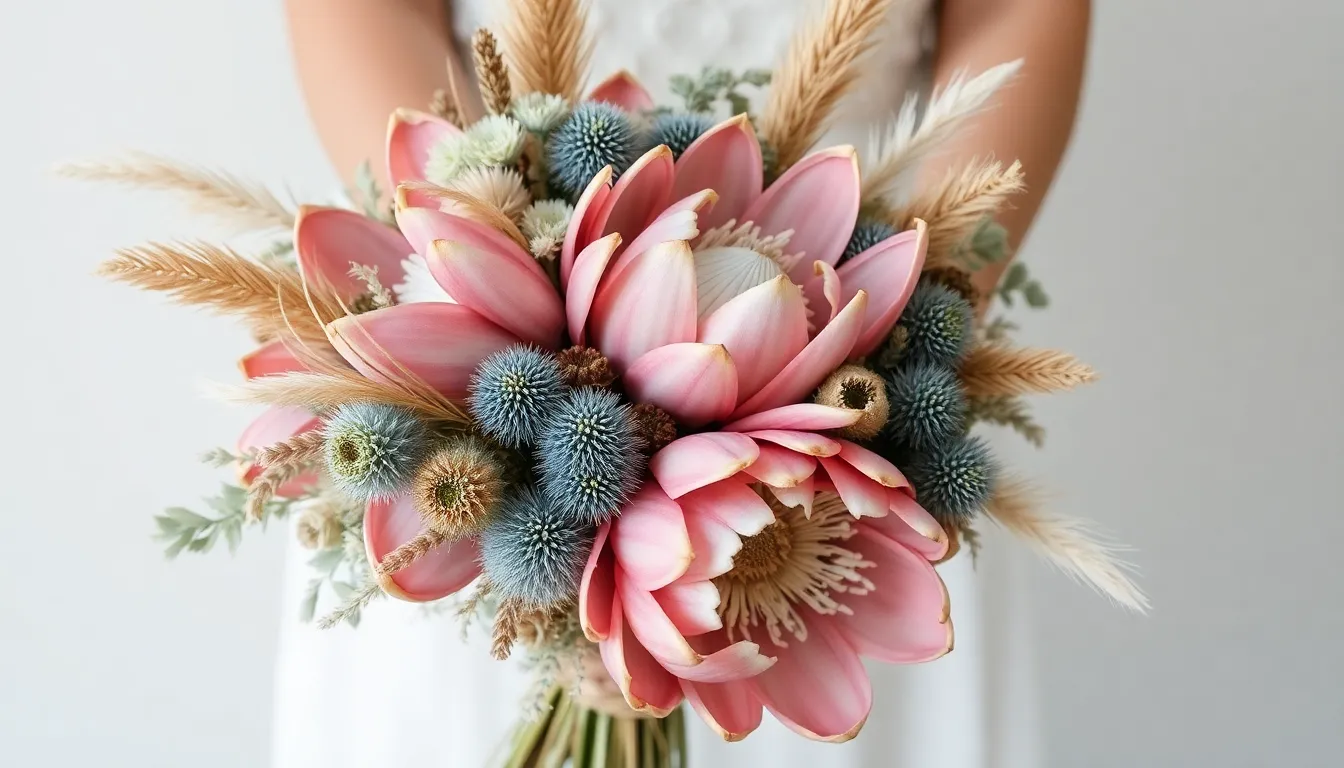
Bohemian dried wedding bouquets reach new heights when we combine the dramatic beauty of king protea with the wild elegance of dried thistle. These striking botanicals create arrangements that perfectly capture the free spirited essence of boho chic weddings.
Feature Bold King Protea Blooms
King protea flowers serve as stunning focal points with their large, striking heads that command attention in any dried wedding arrangement. We love how these robust blooms maintain their dramatic shape and color when dried, delivering the visual impact every bride desires.
Choose neutral or blush toned protea to complement rustic, boho chic, and modern wedding themes seamlessly. These versatile shades work beautifully with various color palettes while maintaining their sophisticated appeal.
Position protea strategically throughout your bouquet to create natural focal points that draw the eye. We recommend using 3 to 5 king protea blooms depending on your bouquet size, spacing them to achieve balanced visual weight.
Rely on protea’s exceptional durability during the drying process, as these flowers retain much of their original form and sense of drama. Unlike more delicate blooms, protea maintains its structure for months or years, making it an ideal choice for keepsake arrangements.
Add Spiky Thistle for Textural Interest
Dried thistle introduces natural, slightly wild textures that perfectly complement the bohemian aesthetic we’re creating. These spiky silhouettes provide striking contrast against softer blooms like protea, adding essential layers of visual and tactile variety.
Select thistle in silver, blue, or muted green hues to enhance your bouquet’s organic, earthy vibe. We find these natural color variations work harmoniously with protea while maintaining the arrangement’s cohesive palette.
Layer thistle throughout your arrangement to create depth and movement, positioning pieces at different heights for the most natural look. This technique mimics how thistle grows in the wild, adding authentic bohemian charm to your dried wedding bouquet.
Combine thistle with additional dried elements such as pampas grass, bunny tails, and eucalyptus for varied shapes and tones. We recommend keeping arrangements loosely structured or hand tied to preserve that casual, artful aesthetic that defines bohemian style.
Build Monochromatic Dried Flower Bouquets
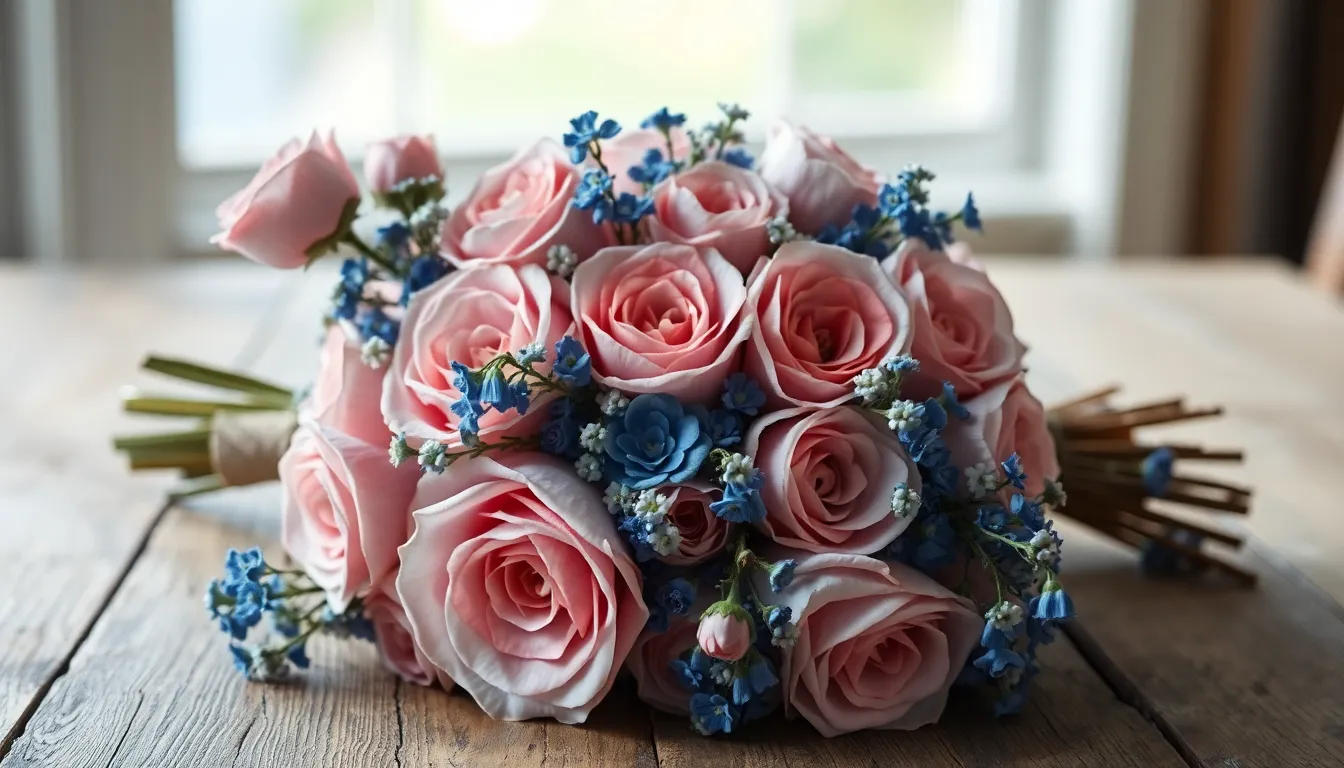
Creating cohesive dried wedding bouquets becomes effortless when we embrace the power of single color schemes. These unified arrangements offer sophisticated elegance while showcasing the natural beauty of dried botanicals.
Focus on Single Color Palettes
Choose one dominant color to establish your bouquet’s foundation and create visual harmony throughout the arrangement. We recommend selecting from nature’s most photogenic dried flower hues like dusty pink marigolds, deep blue larkspur, or golden yellow sunflowers to achieve stunning results.
Work with various shades of your chosen color to build depth without sacrificing cohesion. Pink tones can range from blush dried roses to deeper salmon statice, while blue palettes might include pale larkspur paired with deeper dried delphiniums.
Select flowers that naturally complement your color story by choosing botanicals known for retaining their pigmentation when dried. Statice preserves its vibrant hues exceptionally well, making it perfect for monochromatic arrangements, while sunflowers maintain their cheerful yellow tones throughout the drying process.
Maintain consistency across flower sizes by incorporating blooms of different scales within your chosen color family. Large focal flowers like dried peonies can anchor the arrangement while smaller filler flowers like dried baby’s breath extend the color story throughout the bouquet.
Layer Different Textures in Similar Hues
Combine delicate petals with sturdy foliage to create visual interest while maintaining your monochromatic theme. Soft dried rose petals paired with eucalyptus leaves in similar sage green tones offer textural contrast without disrupting color harmony.
Add seed pods and natural elements that echo your primary color to introduce organic shapes and surfaces. Okra pods in neutral tones complement cream colored arrangements, while pinecones enhance brown and amber themed bouquets with their natural texture.
Incorporate different flower structures within your color palette to build dimensional appeal. Spiky larkspur stems contrast beautifully with rounded marigold heads when both elements share similar color temperatures.
Balance smooth and rough textures by mixing elements like silky dried peonies with textured elements like dried wheat or barley stalks. These combinations create tactile variety while preserving the monochromatic aesthetic that makes these arrangements so visually striking.
Incorporate Unique Dried Elements and Pods
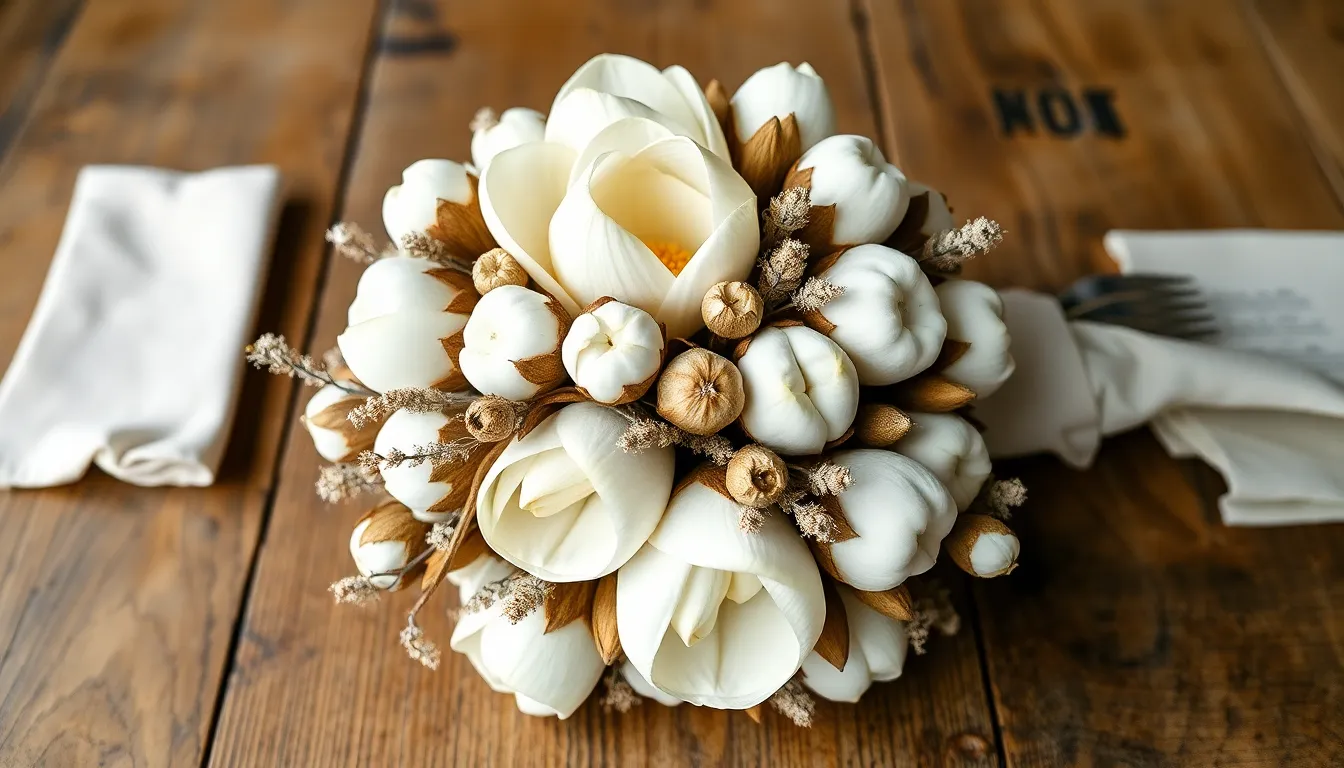
Dried wedding bouquets gain extraordinary character when we incorporate unique architectural elements like pods and natural textures. These distinctive additions create visual interest and tactile appeal that transforms ordinary arrangements into memorable statement pieces.
Add Lotus Pods for Statement Pieces
Lotus pods serve as bold focal points that bring architectural drama to dried wedding bouquets. Their distinctive round shape and natural holes create an organic yet structured aesthetic that works beautifully in both minimalist and elaborate designs. We recommend positioning 2 to 3 lotus pods throughout your arrangement to establish visual anchors without overwhelming delicate dried flowers.
These versatile pods complement various wedding themes from rustic barn celebrations to modern bohemian ceremonies. Their natural earthy tones pair effortlessly with dried roses, pampas grass, and eucalyptus branches. We suggest leaving lotus pods in their natural state for authentic texture or lightly tinting them with spray paint to match your wedding color palette.
Placement matters when incorporating lotus pods into your dried bouquet design. Position larger pods near the center as primary focal points while using smaller ones toward the edges for balanced composition. The pods’ unique texture creates striking contrast against softer elements like cotton bolls or dried baby’s breath.
Include Cotton Bolls for Softness
Cotton bolls introduce gentle whimsical touches that balance firmer dried elements in wedding bouquets. Their fluffy white fibers create beautiful contrast against structured components like strawflowers, wheat stalks, or dried grasses. We love how these soft textures add both visual and tactile interest to arrangements.
The neutral white palette of cotton bolls makes them incredibly adaptable to various color schemes and wedding themes. They work particularly well in bohemian, vintage, and farmhouse inspired bouquets where natural textures take center stage. We recommend clustering 5 to 7 cotton bolls throughout your arrangement for optimal visual impact.
Cotton’s soft appearance photographs beautifully against dried roses and other romantic elements. The fluffy texture catches light differently than smooth dried petals, creating depth and dimension in both professional and candid photos. We suggest trimming cotton stems to varying lengths for a more organic, garden gathered appearance that enhances the overall natural aesthetic of your dried wedding bouquet.
Style Cascading Dried Bouquet Arrangements
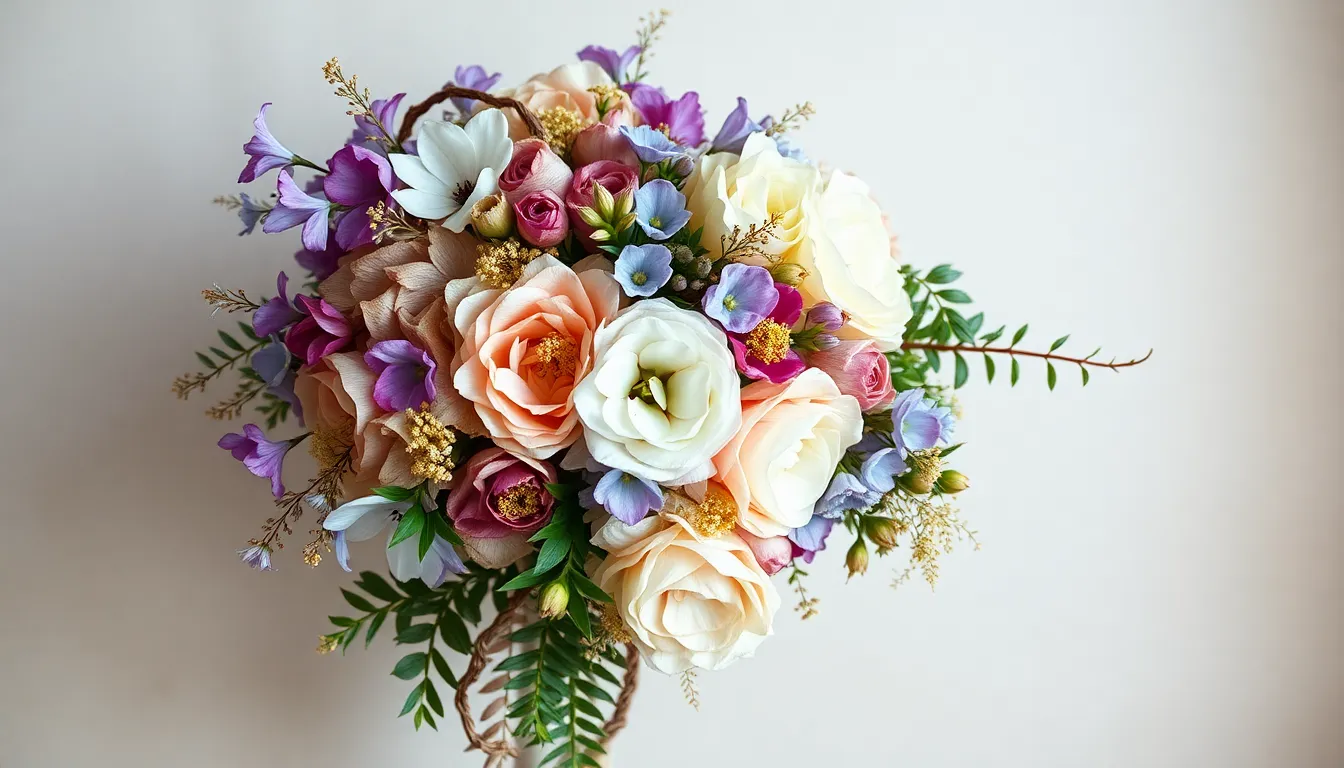
Cascading dried bouquets create stunning waterfall effects that capture attention and add dramatic elegance to your wedding ceremony. These flowing arrangements work beautifully for both carrying and displaying as ceremony focal points.
Create Flowing Waterfall Effects
Building a waterfall effect starts with selecting flowers that naturally cascade downward when arranged. Dried delphiniums offer excellent height and graceful drooping stems that form the foundation of your flowing design. Hydrangeas provide volume and softness while maintaining their shape beautifully when dried.
Positioning becomes crucial when creating the waterfall illusion in your dried bouquet. Place your tallest elements like delphiniums at the back and center, allowing shorter stems to flow forward and downward. Baby’s breath works wonderfully as a filler, creating gentle cascades between your focal flowers.
Securing your arrangement requires careful attention to stem placement and wire support. We recommend using floral wire to gently bind stems at different heights, ensuring each flower maintains its natural flow. This technique prevents the bouquet from looking too structured while keeping the waterfall effect intact.
Use Trailing Elements Like Dried Ivy
Dried ivy serves as the perfect trailing element to enhance your cascading bouquet’s natural movement. This versatile foliage can be woven throughout your main flowers or positioned to flow from the bottom of your arrangement. Its flexibility allows you to create gentle curves and organic shapes that complement your dried blooms.
Incorporating dried grapevine adds another dimension to your trailing elements collection. These woody stems provide structure while maintaining a natural, flowing appearance that works well with rustic wedding themes. Position grapevine pieces strategically to guide the eye downward and create visual interest.
Dried ferns offer delicate texture and feathery trails that soften the overall appearance of your bouquet. These elements work particularly well when combined with stronger focal flowers like king protea or garden roses. Layer different lengths of dried ferns throughout your arrangement to achieve a natural, garden gathered look that photographs beautifully.
Plan DIY Dried Wedding Bouquet Projects
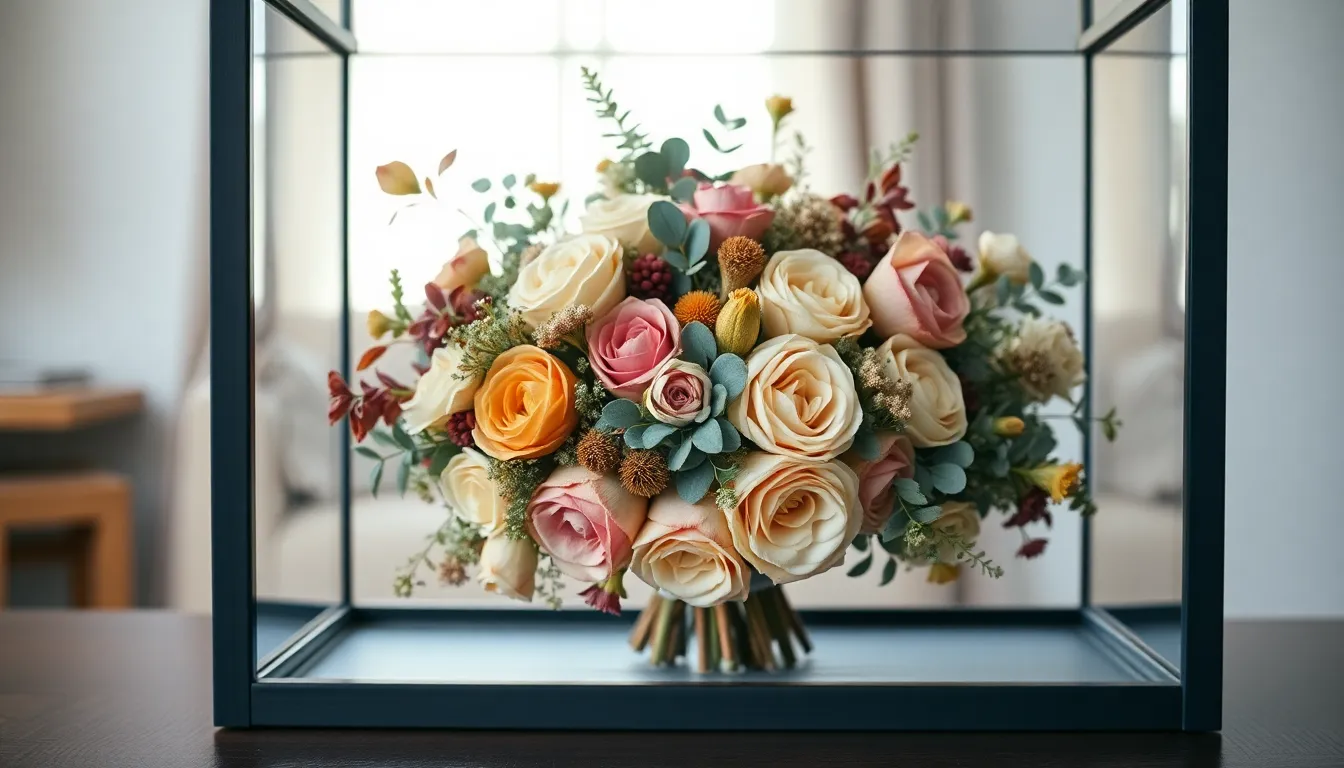
Creating your own dried wedding bouquet projects allows you to transform fresh flowers into lasting keepsakes. We’ll guide you through sourcing materials and mastering preservation techniques that ensure beautiful results.
Source Materials from Local Suppliers
Flowers form the foundation of our dried bouquet projects, whether we use leftover blooms from the wedding ceremony or purchase fresh varieties specifically for drying. Local florists often provide the best selection of flowers suitable for preservation, offering expert advice on which varieties maintain their beauty longest. Garden centers frequently stock seasonal blooms that dry exceptionally well, including roses, lavender, and eucalyptus.
Silica gel serves as our primary drying agent for preserving flower shape and color integrity. Most create stores carry this essential material, though online retailers often offer bulk quantities at better prices. Art supply stores typically maintain consistent inventory of silica gel products designed specifically for flower preservation.
Shadow boxes protect our finished dried arrangements from dust accumulation and color fading over time. Framing shops provide archival quality options that ensure long term preservation of delicate petals. Home decor stores offer various sizes and styles to complement different interior design themes.
Resin supplies enable us to create permanent art pieces featuring our preserved wedding flowers. Art supply stores stock both epoxy and UV resistant resins suitable for botanical preservation projects. Online specialty retailers often provide complete resin kits that include all necessary tools and materials.
Learn Proper Drying and Preservation Techniques
Air drying represents the most traditional method for preserving wedding bouquets naturally. We hang flowers upside down in dark, temperate areas for at least two weeks to prevent color fading. Alternatively, we can press individual flowers between parchment paper and heavy books before hanging them separately to complete the drying process.
Silica gel drying accelerates the preservation timeline while maintaining superior shape retention. We submerge flowers completely in silica gel crystals, following manufacturer instructions for optimal timing. This method particularly benefits delicate blooms that might lose their form through traditional air drying techniques.
Storage protocols protect our dried flowers from environmental damage throughout their lifespan. We keep preserved arrangements away from direct sunlight exposure to prevent color degradation. Moisture control becomes critical, as humidity can cause dried petals to become brittle or develop mold over time.
Display methods maximize the visual impact of our dried wedding bouquet projects. Shadow box mounting creates museum quality presentations that showcase intricate flower details. Resin embedding produces stunning decorative pieces that capture flowers in crystal clear permanence, serving as conversation starters and cherished mementos.
Consider Seasonal Dried Flower Options
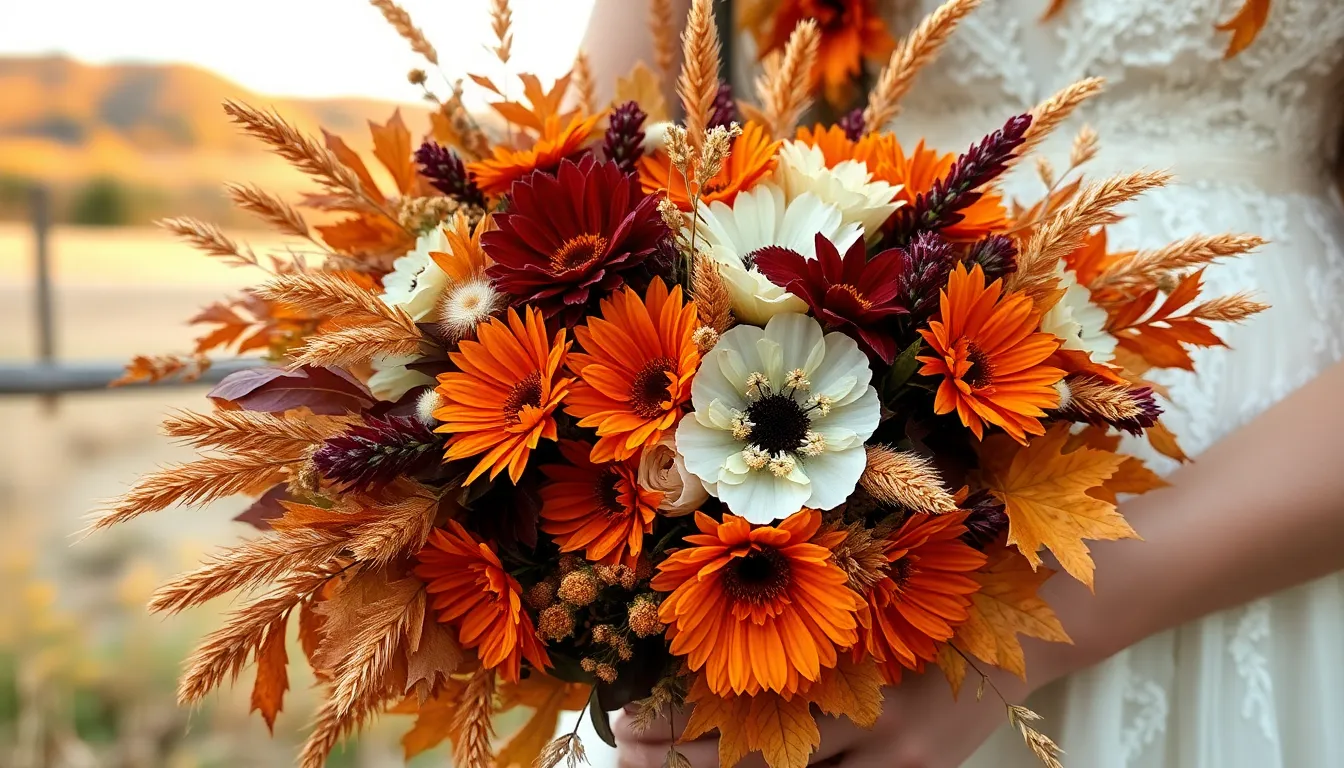
Matching your dried bouquet to your wedding season creates a harmonious connection between your special day and nature’s rhythm. We recommend selecting dried flowers and elements that naturally complement your ceremony’s timing and overall aesthetic.
Choose Autumn Elements for Fall Weddings
Autumn weddings call for warm, rich tones that mirror the season’s natural beauty. We suggest incorporating dried oak leaves into your arrangements, as their deep bronze and amber hues create stunning focal points that capture fall’s essence perfectly.
Orange cosmos add vibrant pops of color while maintaining their brilliant shade throughout the drying process. These cheerful blooms pair beautifully with burgundy statice, which offers excellent color retention and adds texture to your seasonal arrangement.
Dried wheat stalks work wonderfully as structural elements in fall bouquets, providing golden tones that complement the harvest season theme. We recommend bundling these stalks in small clusters and varying their heights to create natural movement within your design.
Consider adding dried maple leaves or sumac branches for additional autumn character. These elements bring organic shapes and rich colors that photograph beautifully against fall wedding backdrops.
Select Bleached Materials for Winter Ceremonies
Winter weddings benefit from bleached and white dried materials that evoke the season’s crisp, pristine atmosphere. Bleached baby’s breath creates an ethereal, snow-like quality that adds romance and delicacy to winter arrangements.
White statice serves as an excellent foundation flower, maintaining its pristine color while providing sturdy structure for your bouquet design. We find this bloom particularly effective when paired with other bleached elements for a cohesive winter palette.
Bleached pampas grass offers dramatic texture and movement, creating stunning silhouettes that complement winter’s stark beauty. These plumes photograph exceptionally well against winter landscapes and formal wedding attire.
Silver dollar eucalyptus in its natural state provides subtle color variation while maintaining the winter theme’s elegance. We recommend using these stems as accent pieces to break up solid white areas and add visual interest to your arrangement.
Cotton bolls naturally complement winter themes with their soft, cloud-like appearance. These elements add whimsical touches that balance the more structured bleached flowers while maintaining the season’s sophisticated aesthetic.
Conclusion
We’ve explored countless ways to create stunning dried wedding bouquets that’ll become treasured keepsakes for years to come. From classic eucalyptus combinations to dramatic cascading arrangements with protea and thistle these options offer something special for every bride’s unique style.
The beauty of dried flowers lies in their versatility and lasting appeal. Whether you’re drawn to bohemian pampas grass arrangements or vintage-inspired rose and lavender combinations you can create a bouquet that perfectly captures your wedding day magic.
With proper planning and the right techniques these dried arrangements will preserve your most precious memories while adding natural elegance to your home décor. Your wedding bouquet doesn’t have to be a fleeting moment – it can be a beautiful reminder of your special day that lasts forever.
Frequently Asked Questions
What are the main benefits of choosing dried wedding bouquets?
Dried wedding bouquets offer several advantages including long-lasting beauty that preserves memories, no concerns about wilting petals during ceremonies, and the ability to keep them as permanent keepsakes. They provide a romantic vintage aesthetic with bohemian charm, photograph beautifully, and can be displayed in your home for years. Additionally, they’re often more budget-friendly and environmentally sustainable than fresh flowers.
Which flowers work best for dried wedding bouquets?
The best flowers for dried bouquets include roses, eucalyptus, baby’s breath, pampas grass, lavender, and protea. These flowers maintain their shape and color well during the drying process. Other excellent choices include wheat stalks, thistle, delphiniums, hydrangeas, and cotton bolls. Choose flowers with sturdy stems and petals that hold their structure when dried for the best results.
How do I create a cascading dried bouquet arrangement?
To create a cascading dried bouquet, select naturally flowing flowers like dried delphiniums and hydrangeas as your base. Position these elements at varying heights to achieve a waterfall effect. Add trailing elements such as dried ivy or grapevine, and incorporate fillers like baby’s breath and dried ferns. Layer different textures and lengths to create natural movement and dramatic elegance in your arrangement.
What’s the best way to dry wedding flowers at home?
The most effective drying methods include air drying and using silica gel. For air drying, hang flowers upside down in a dry, dark place with good ventilation for 2-3 weeks. Silica gel provides faster results (3-7 days) and better color retention. Remove excess moisture, place flowers in silica gel, and store in airtight containers. Protect dried flowers from humidity and direct sunlight.
How can I match my dried bouquet to my wedding season?
For autumn weddings, incorporate dried oak leaves, orange cosmos, and burgundy statice. Winter ceremonies benefit from bleached materials like white baby’s breath, cream pampas grass, and cotton bolls for a crisp atmosphere. Spring arrangements can feature soft pastels with dried roses and eucalyptus, while summer bouquets work well with golden wheat stalks and sun-bleached botanicals for a natural, seasonal connection.
What are some popular color schemes for dried bouquets?
Popular color schemes include monochromatic arrangements using single colors like dusty pink, deep blue, or golden yellow. Neutral palettes with cream, beige, and soft browns create timeless elegance. Vintage-inspired combinations feature muted tones like dusty pink, cream, and soft peach. Bohemian styles often incorporate natural earth tones with pops of burgundy, rust, or deep purple for added drama.
How do I incorporate unique elements like lotus pods and cotton bolls?
Use lotus pods as bold focal points by positioning 2-3 strategically throughout your bouquet to create visual anchors without overwhelming other flowers. They can be left natural or lightly tinted to match your color scheme. Cotton bolls add soft, whimsical texture—cluster them in groups of 3-5 and trim stems to varying lengths for an organic appearance that balances firmer dried elements.
What wrapping options work best for dried bouquets?
Vintage-inspired wrapping options include lace, burlap, or vintage ribbon that enhance the dried bouquet’s nostalgic charm. For bohemian styles, consider natural jute, leather cord, or raffia. Classic arrangements work well with satin ribbon or silk ties. Choose wrapping materials that complement your wedding theme and the bouquet’s color palette while providing adequate stem coverage and comfort for handling.

